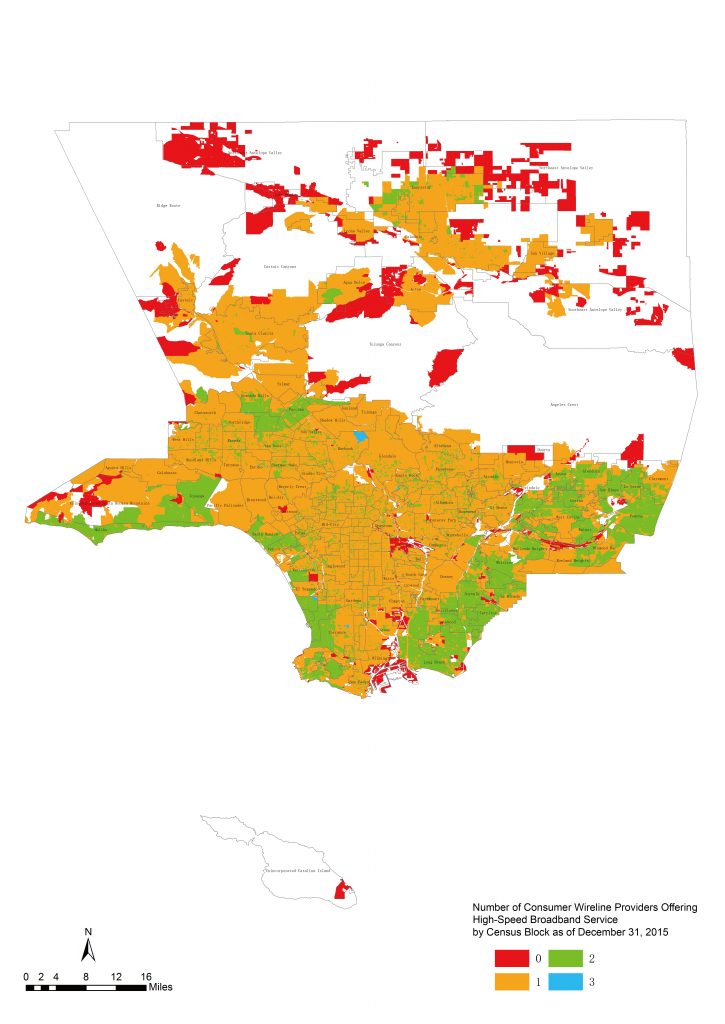Broadband: We must do better
(This article was originally published on The Conversation)
By Hernan Galperin, François Bar and Annette M. Kim
Los Angeles is home to some of the most creative people and businesses in the planet. Our filmmakers, musicians, visual artists, software engineers and scientists entertain the world and push the knowledge frontier forward. Their process is often a mystery, but their tools are not. Underpinning their intellectual pursuit is broadband Internet access, which fosters creativity and innovation by enabling access to information and supporting collaborative work. Broadband is the enzyme that accelerates the creative economy, much like waterways, railroads and roads fueled the industrial era.
But there is a catch: our world-class creators live in communities where broadband services are far from world-class. Using data from the California Public Utilities Commission, we created an interactive tool that maps the availability of different broadband services for every census block in Los Angeles County. We then combined the maps with socioeconomic data, which allowed us to analyze the relation between Internet infrastructure and community demographics in close geographical detail.
Our results indicate that nearly two-thirds of Angelenos live in areas served by a monopoly provider of residential Internet connectivity offering speeds that meet the Federal Communications Commission’s current definition of “broadband” service (25 Mbps download/3 Mbps upload speeds). Unsurprisingly, there is more competition in the wealthier coastal communities and in the San Fernando Valley. All else equal, weak competition yields higher prices for consumers and little pressure for companies to upgrade their networks to offer better service. In short, it preys on the less wealthy and stifles innovation.
The broadband landscape in LA County reflects two underlying trends. The first is the generalization of duopoly competition between DSL (which uses existing landline telephone wires to deliver broadband) and cable-Internet services. Our maps show that there is almost no geographical overlap between competitors with the same technology. Of the more than 73,000 census blocks in LA County, only about 2,500 (approximately 3 percent) are served by more than one DSL provider, and only 850 blocks (about 1 percent) are served by more than one cable-internet provider. Alas, the majority of households have to choose between one cable provider and one DSL provider, whose services often fail to meet the FCC broadband speed threshold.

Number of High-Speed Broadband Providers in LA County
The second major trend is ongoing industry consolidation in the telecom and cable-TV markets. In the case of Los Angeles, the acquisition of Time Warner Cable by Charter Communications in May 2016 only seemed to makes things worse, sparking public debate about stricter antitrust rules for the industry. However, when analyzed with geographically disaggregated data, the merger has had a very modest impact. Before it was completed, less than 1 percent of Angelenos lived in areas serviced by both operators. In other words, the cards were stacked against competition long before the most recent wave of industry consolidation.
A key barrier to competition in home broadband is the expense of installing wired networks across large urban areas. In the past, federal policies required companies with existing networks to allow competing providers to serve customers using those same wires. But those days are gone, largely due to successful litigation against the FCC by incumbent cable and phone companies. As a result, many cities have taken matters into their own hands.
In 2014, Mayor Eric Garcetti launched CityLinkLA, an initiative aimed at securing private investments in advanced communications networks and providing ‘basic access to all for free or at a very low cost and gigabit (1 Gbps) or higher speed access at competitive rates.’ Despite initial momentum, the initiative has so far failed to attract the necessary investments in new broadband infrastructure, particularly for gigabit-speed services. Our analysis indicates that fiber-based services (capable of delivering speeds far faster than cable or DSL) are available in less than a quarter of census blocks in Los Angeles. For comparison, fiber coverage in cities like Paris and Seoul is approaching 100 percent. Further, fiber investments are more likely in wealthier areas, which in the long-run will only exacerbate disparities in socioeconomic opportunities across communities.
Geography and demographics present real challenges to the rollout of advanced network infrastructure in Los Angeles County. However, if our artists, entrepreneurs and scientists are to continue thriving, and if we seek to build new opportunities for struggling communities, we simply must do better. Help is unlikely to come from Washington, where the newly-appointed FCC chairman has consistently voted against federal subsidies for broadband expansion projects. Rather, we should look at the example of communities across America, large and small, that are building upon existing city assets to deploy and operate their own fiber networks. LADWP already owns over 800 miles of fiber across the City of Los Angeles, with significant spare capacity. This and other city assets must be leveraged to offer Angelenos the world-class broadband they deserve.